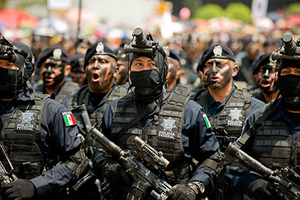MexicoNew Mexican government to set up a new police force to fight drugs, crime
Mexican president Enrique Pena Nieto has said his government would create a new national police force as part of a new approach to dealing with drugs, crime, and violence; Pena Nieto took office on 1 December; the new, militarized police force would have about 10,000 officers initially, but would eventually grow to 40,000

Mexican federal police in formation // Source: lahojillaentv.com
Mexican president Enrique Pena Nieto has said his government would create a new national police force as part of a new approach to dealing with drugs, crime, and violence. Pena Nieto took office on 1 December.
The new, militarized police force would have about 10,000 officers initially. Mexico is currently policed by different police forces at local, state, and federal level with different responsibilities and chains of command
Since December 2006, when former president Felipe Calderon began a new offensive against the drug cartels, more than 60,000 people have died.
During his campaign, Pena Nieto, the candidate of the venerable PRI party which ruled Mexico from the 1920s until the late 1990s, said he would switch the focus law enforcement in the war on drugs from tackling the gangs to reducing crime and violence.
The BBC reports that the new police force will be modeled on European-style gendarmeries, with the focus on basic law enforcement duties.
On Monday, when he unveiled his 6-point program to revamp Mexico’s law enforcement, Pena Nieto said the force would initially have 10,000 officers, but he gave no details about the time frame fro recruiting and training them. Observers say the force would eventually number 40,000.
The plan calls for establishing fifteen federal police units to deal specifically with kidnapping and extortion.
Also speaking during Monday’s unveiling of the new police plan was the new interior minister, Miguel Osorio Chong. He said that the outgoing Calderon administration was right to say that spending on security had gone up — but crime has gone up too: Kidnapping by 83 percent, violent robberies by 65 percent, and extortion by 40 percent.
